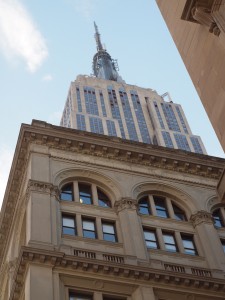
The Empire State Building, a National Historic Landmark, achieved LEED Gold under LEED EB: Operations & Maintenance in 2011.
Since 2007 I have been working with the National Trust for Historic Preservation to review the new drafts of LEED. The third draft of LEED 2012 is out for public comment from March 1st to March 20th. Today, we posted our thoughts on this final version of LEED 2012 on the Trust’s PreservationNation Blog.
LEED 2012 will be the first version in which historic preservation values are included consistently throughout all 18 rating systems. There is now a specific credit in the Materials and Resources category that provides 4 points specifically for historic buildings with no significant burden of proof beyond documentation of existing landmark status. The legal definition of historic buildings, landscapes and sites, both local landmarks and state and National Register-listed landmarks, are provided and properly acknowledged throughout the systems. There are now a variety of credits that provide exemptions for historic buildings. Still, we remain concerned that the amount of points available for reuse of existing and historic buildings does not adequately reflect the positive environmental action of reuse over new construction.
More and more historic buildings are achieving LEED certification as part of their stewardship process. In the past year two National Historic Landmarks, the Empire State Building in New York City and the Treasury Building in Washington, DC have received LEED Gold for LEED EB: Operations & Maintenance. If you’re interested in understanding more about LEED and historic preservation, consider coming to sustainable preservation workshops that the University at Buffalo has organized this spring in Buffalo and New York City. And if you’d like to comment on LEED 2012 yourself, check out my “Top Ten” list.
And if you’d like to “subscribe” or follow this blog, True Green Cities, please sign up through the “Subscribe” button at the bottom left of this page. You’ll receive a daily recap when new blogs are posted.
